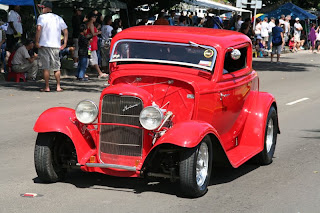Our favorite Thursday event, hiking with Rec-n-Crew, was a
history lesson.
Next Thursday is Liberation Day -
the celebration of the U.S. Marines
landing on Guam to take the island back from the Japanese;
July 21, 1944.
(*you can read more about
it here)
The island of Guam celebrates Liberation Day in a
BIG way.
In case you don't know the history, December 7th 1941 was not just the bombing of Pearl Harbor.
It was also the capture of Guam by the Japanese. (although, in Guam, it was already December 8th)
The Japanese also took over many of the smaller islands around Guam as well,
Rota,
Tinian, and
Saipan.*
(*these three islands are now considered the Commonwealth of the U.S.)
The Japanese ruled over Guam and its people for two and a half years.
They treated the people of Guam, the Chamorro people, very harshly.
Much in the same way that Hitler was treating Jewish people.
For this reason, they celebrate the freedoms they received from the recapture of the island by the U.S. Marines. The battle was three weeks long, and the loss of life was large. But it was possibly one of the
turning points in WWII. The U.S. regained its position in the Pacific, and its advantage in the war.
Here are some photos of the sites.
Sumay Cove is the historic site of a once, thriving Chamorro Village.
This cross, and a few pieces of walls, are the only things that remain from the bombings from both the Japanese in 1941 and also the Americans in 1944.
 |
| Japanese Sub from WWII |
 |
| Piti Guns |
These guns were hauled up the rugged hillside by the local people enslaved by the Japanese.
They are massive and I can't imagine how heavy.
They were placed here to defend the harbor against the Americans.
Because the Japanese knew that, eventually, the U.S. would return to the island.
The guns were put into place just days before the Americans landed.
Ammo for the two smaller guns never arrived, and the guns have never been fired.
The Japanese used the landscape of Guam to their advantage.
This cave in the mountain side leads down to the beach,
where a large gun was placed to defend the beach head.
The cave might have served as a quick escape route,
as well as a dry place to store supplies.
 |
| pill box at the top of Asan Ridge |
 |
Overlooking Asan Beach -
where the Marines landed on July 21st 1944,
from the location of the pill boxes atop Asan Ridge
|
 |
Memorial to the U.S. Marines -
placed on the 50th anniversary of Liberation Day |
 |
Asan Bay Overlook - the location of the Japanese Commander's headquarters
It took a little over six days for the Marines to make it from the beachhead to the top of the ridge
fighting hand to hand combat as well as taking fire from both above and below them.
Most of the men fighting were barely out of high school. |
Historic photos can be found
here - at the National Parks Website.
Thank you to the Seabees of NMCB-133
who came out and cleared the trail a couple weeks before our hike.
A special thank you to the Park Rangers; Ranger Dan and Ranger Jim.
Also, a big shout out to Miss Barbara from Rec-n-Crew for all she does to make our Thursday hikes (and this tour) a great success.
Last but not least:
Thank you to those Marines and their families who paid the price for Chamorro freedom.
You are not forgotten.




























































